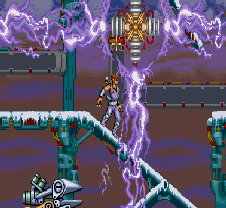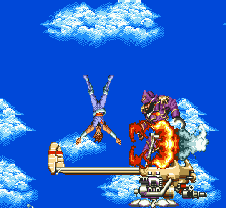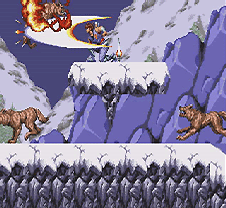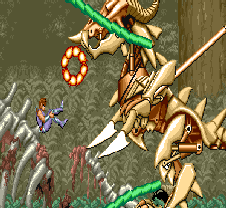
Strider: Capcom’s classic ‘Ninja vs. Cosmonauts’ platformer.
Mark
Today’s exhibit from the Perfekt Past vault has a special place in my heart as not only is it a great action-platformer but it also has the distinction of being the first Megadrive (Read: Genesis for our non-European readers) game I ever played. It was the very early nineties and a friend of my older brother boasted that he’d bought a Japanese game for his new Sega Megadrive.
“Will that work in a British machine?†I asked. “Sure, you need a converter to play it or you can use a hacksaw to cut the sides off the cartridge.†he claimed. I never took a hacksaw to a NSTC cartridge but I did use the fabled converter (a small rickety piece of circuit board that bridged the NSTC cart and PAL cartridge slot and had to be in ‘just’ the right way to work) to play a few games as then unreleased in the UK the first of which was this…

Are Striders electric?
‘a boss confrontation inside a mosque’
The original Strider was made by Capcom for their CPS-1 arcade system back in 1989 and was a mix of platforming action with the title character Strider Hiryu able to somersault, climb walls and hang from platforms thanks to his handy climbing claws. To defend himself from the hoards of enemies all looking to make him explode into a shower of light (yeah, don’t ask) he has his falchion, a plasma sword that can cut through most enemies with a single swipe but has a very short range unless you manage to find a upgrade to increase the size of its arc.
Other collectable upgrades include energy replenishing and extending symbols as well as a variety of drones that will follow you and attack any enemies nearby and standard 1-ups and short term invincibility. All of this is used by Hiryu to thwart the plans of the Grandmaster Meio, a Palpatine style bad guy who has used his third moon battle station to enslave earth and take control of Earth. All of which is conveyed by some semi-bizarre dialogue between levels along with some hammy voice acting.
Strider’s setting is a unique mix of future sci-fi set in 2048 across different locations in Asia, Africa and space with the opening level set in St. Petersburg that has you scaling rooftops and minarets before a boss confrontation inside a mosque. Later levels take in a wide variety of vistas with snowy caves and mountains in Siberia to battles on airborne destroyers that include zero-g sections and even a quick stop off in the Amazon jungles before storming bad guy Meio’s third moon battle station in orbit of Earth.

Hiru the cabin boy
‘you’re trapped in a cave with a giant robot monkey’
Now when you think about levels in a game you can normal break them down in your minds eye to tile set placed and arranged to make interesting gameplay with an inherent structure and repetitiveness. However one of the many things that make Strider great is the fact that almost every level doesn’t follow this formula but rather has bespoke quality making it look and play like a collection of action packed set pieces from a movie script rather than just a set of placed background tiles.
The second level is a great example of the bespoke nature of the game. The first ‘area’ has you fighting off wolves before you’re trapped in a cave with a giant robot monkey (I don’t know why they chose a monkey other than it looks cool) that must be defeated to advance. Hiryu then has to scale the cave walls up to a chamber filled with rotating platforms and wheels before ascending through and up to the mountain top where he is attacked by Solo an airbourne bounty hunter in the employ of Grandmaster Mido. You can beat Solo or just run past him either way you have to run as fast as you can down the mountainside as it explodes and jump a chasm over to the powers station on the other side.
Once there you need to avoid more wolves, some big robots and the huge electrical arcs being discharged all around the station (which looks wicked cool by the way) until you can jump off the top of the station a grab a passing hover transport. From there the only way is up as you jump from transport to transport defeating the pilots and dodging bombs being dropped by the bigger airship you reach after hopping off the final transport. Then it’s just a case of getting to the bridge and defeating a trio of female assassins and Solo if you avoided him before. Phew.

Thrown to the wolves
‘replaced with a chubby Shatner look-alike’
Every stage is like this with a narrative going on amongst the action packed scenes with hardly any repetition in the scenes save for the final stage where some previous bosses return for vengeance including a stunning scene where you have to ride Ouroboros across the third moon to your final confrontation with Grandmaster Meio atop a huge radio mast. Once you add to this the great music, with each level having different themes for the set pieces and special themes for the characters, you’ve got an absolute stone cold classic that has to be played.
The only negative comments I can make about it is down to how Strider has been treated in the past. Lacklustre cover art was commonplace for Megadrive games but Strider’s was especially offensive with the original manga style artwork replaced with a chubby Shatner look-alike being spied on by some space marines from Warhammer 40,000. The home versions apart from the near perfect port on the Megadrive were all gash and the NES version was totally different instead being based on the Strider manga comic that removed the whole Grandmaster Meio plotline replacing it with Hiryu running around the world looking for enemy officers to capture to increase his available skills.

A bad time to use the slip 'n' slide
‘made by Tiertex and was a complete load of bollocks’
The sequel Strider Returns was made by Tiertex and was a complete load of bollocks that removed all the great ideas from the original, replacing them with bland clichéd stages and other nonsense like transforming into a robot for boss fights. Things where improved much later with Hiru having cameos in some Capcom beat ’em ups and a proper Strider 2 sequel but even this fell far short of the originals greatness leaving it almost unique in the genre when compared to its fellow Capcom games of the time like Black Tiger or even Ghouls ‘n’ Ghosts.
Playing Strider today is easy thanks to Capcom whoring it out on various retro compilations on a half dozen different formats and the Megadrive conversion can be found for just a few quid on any good online videogame retailer. Who knows if we can generate some interest in the IP maybe Capcom could pull a Resi and give Hiryu a makeover for the next generation or at least an Xbox Live Arcade sequel. After all it couldn’t be any worse than Commando 3 or 1942: Joint Strike.
